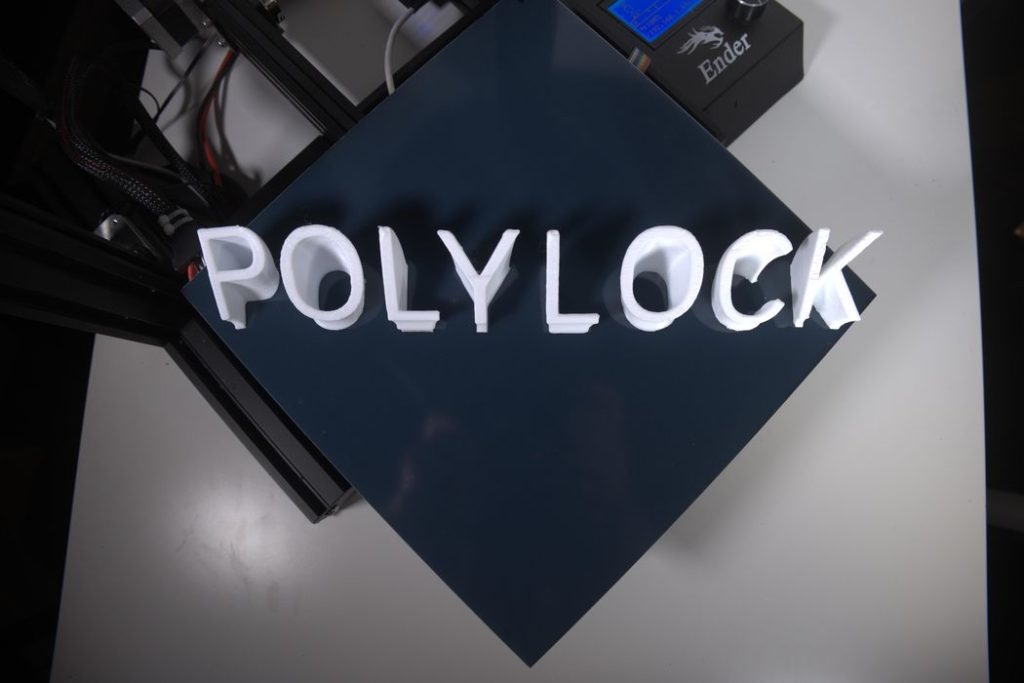
3DQue announced the availability of a new and advanced adhesion solution for desktop 3D printers: PolyLock.
The Vancouver-based company has been developing variations of this technology for some time, creating 3D printing array solutions and upgrade kits along the way. Their most recent release was the Quinly kit that transformed devices like the Creality Ender 3 into a continuous 3D printer, requiring no human intervention in-between prints.
This technology, called VAAPR, works so well it’s possible to 3D print objects when the printer is oriented at 90 degrees — sideways! 3DQue uses this capability to enable continuous 3D printing: the prints simply fall off the bed when done.
The new product, PolyLock, uses similar tech as Quinly, but can be installed on a wide variety of popular desktop 3D printers. PolyLock also has a higher adhesion level, which allows it to be used with even more materials. Here is a list of the devices currently supported:
- Ultimaker 2 Go
- Printrbot Play
- Printrbot Simple Metal
- Lulzbot Mini
- Solidoodle Workbench Apprentice
- Creality Ender 2
- Prusa Mini
- FlashForge
- Dremel
- Makerbot Replicator 2x
- Makerbot Replicator 2
- RepRap Solidoodle Press
- Anet A8
- Prusa MK3+
- Pulse
- Robo 3D
- Ultimaker 2+
- Ender3/5 CR-20
- Printrbot Plus
- Robo R1+
- Lulzbot Taz 4 & 5
- Solidoodle Workbench
- CR-10
- Folger Tech FT-5
- TEVO Black Widow
- Ultimaker S5
- Raise3D Pro2
- Ender 5 Plus
- Voron 2
Basically they’ve produced multiple sizes of the PolyLock sheet, and these sizes fit many different 3D printers. Pricing ranges from US$24 for the lowest size, 11 x 11 cm, to US$159 for the largest size, 35 x 35 cm.
How does PolyLock work? It’s all about the temperature. When it’s heated, material will stick extraordinarily well, and when the bed cools down, the part is completely released. 3DQue explains:
“(You) can easily pluck parts off the bed without using scrapers, razors or other tools.”
This is notable because most adhesion solutions do require some scraping at times, and any scraping can damage the surface. It’s best to be entirely avoided, and that’s the case with the PolyLock.
Adhesion solutions tend to be material-specific. For example, the most commonly used adhesion solution, PEI, is useful for certain materials, but not others. You might have to coat your PEI print bed with tape or spray it with ammonia, depending on which material is in use.
On the other hand, PolyLock handles a wide variety of materials, including the most common 3D printing filaments: ABS, PLA, PP, TPU, PC, Nylon, ASA, HIPS and more. This means a PolyLock-equipped desktop 3D printer would rarely have to deal with alternate adhesion solutions.
3DQue also said prints will not require glue, tape, or even brims to stick properly. However, you may still require a raft depending on the object’s geometry.
No special chemicals are required to clean a PolyLock surface; you need only water and soap.
Finally, each PolyLock comes with a lifetime guarantee against defects, so it’s a durable adhesion solution.
In the early days of desktop 3D printing, adhesion was always the biggest issue. Many different solutions were attempted, and most worked to some degree, but were difficult and often messy to implement. Later we saw the introduction of the now de facto standard spring steel plate with PEI surface that revolutionized adhesion.
What’s the next step forward in adhesion solutions? Could the VAAPR technology be the way of the future? Might we see massive continuously operating 3D printer farms using PolyLock?
Via 3DQue
